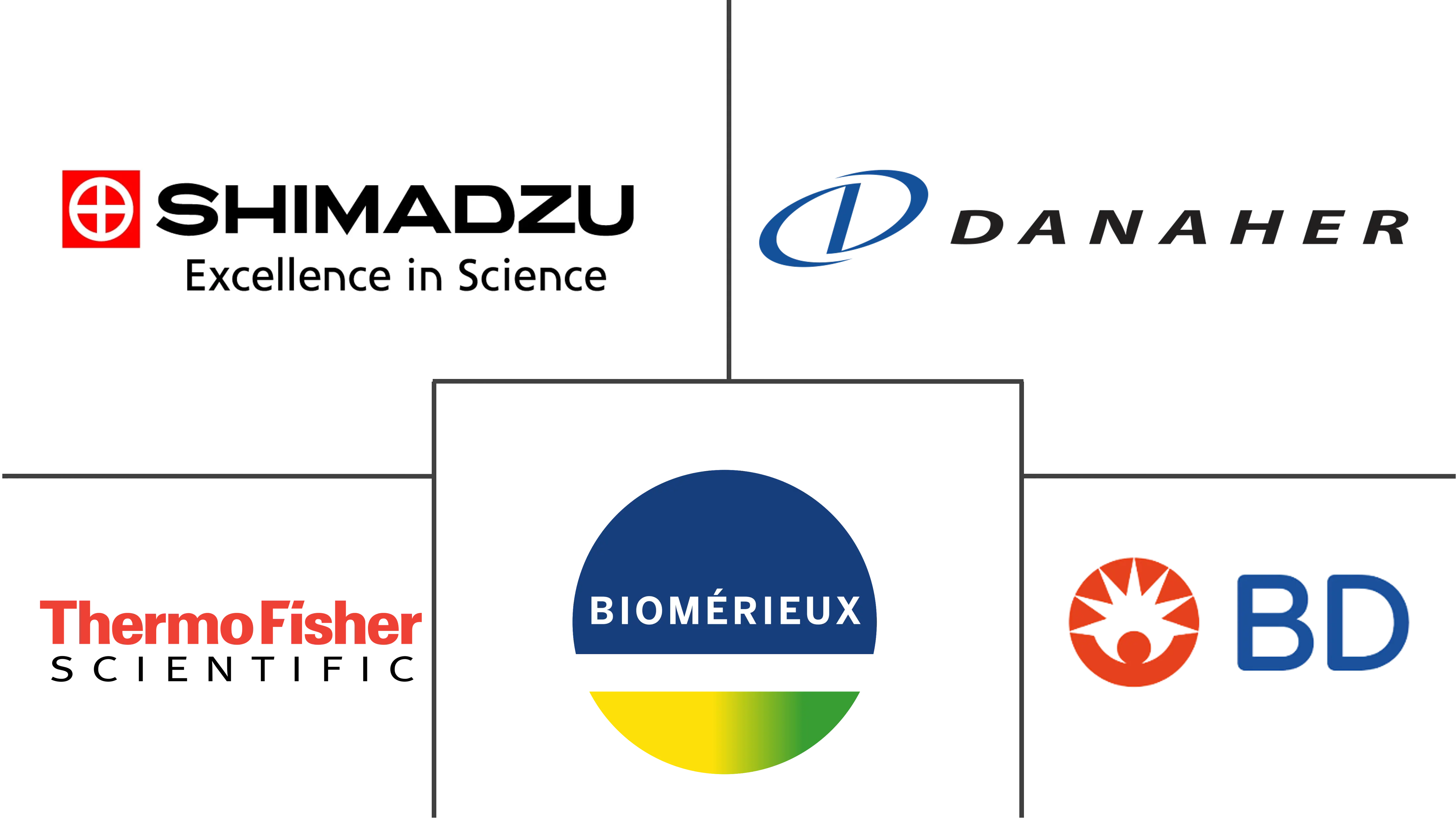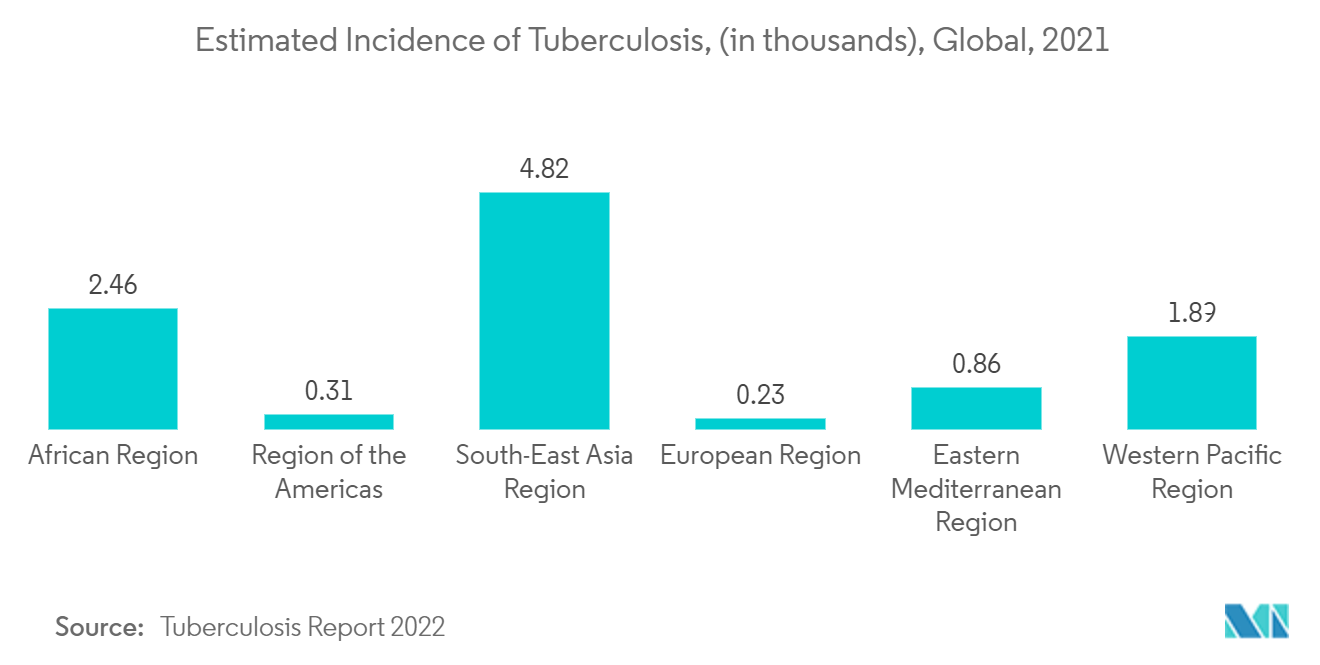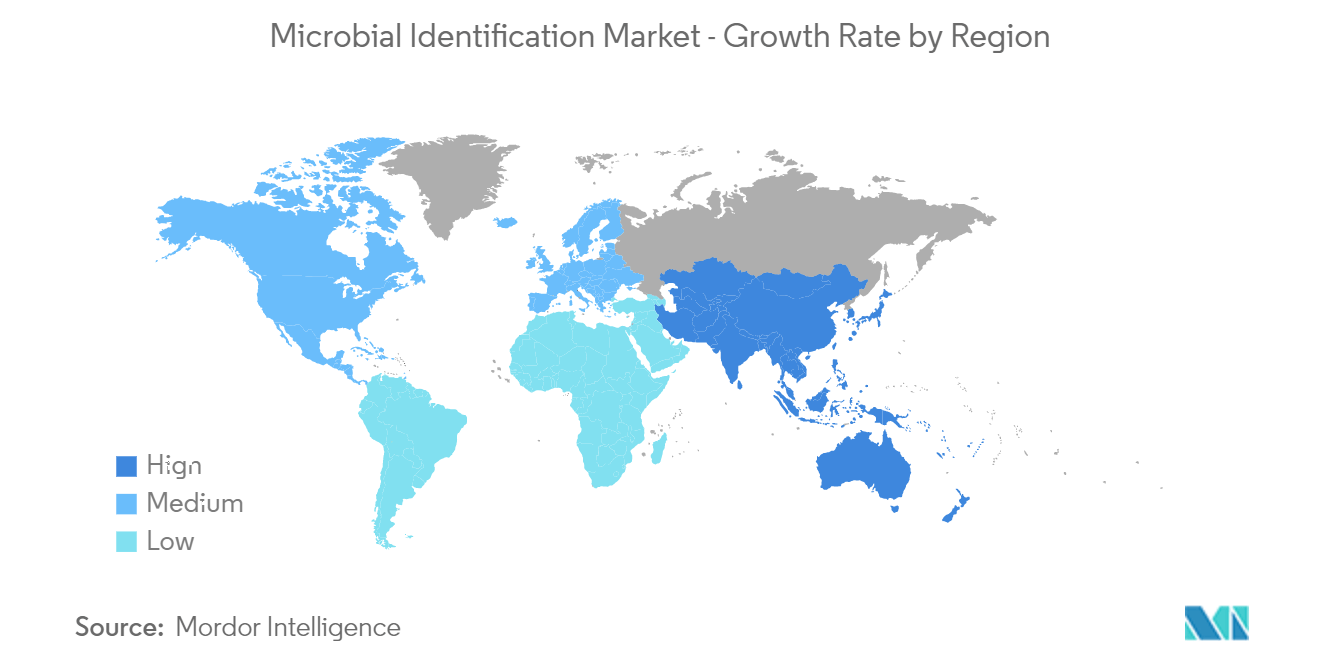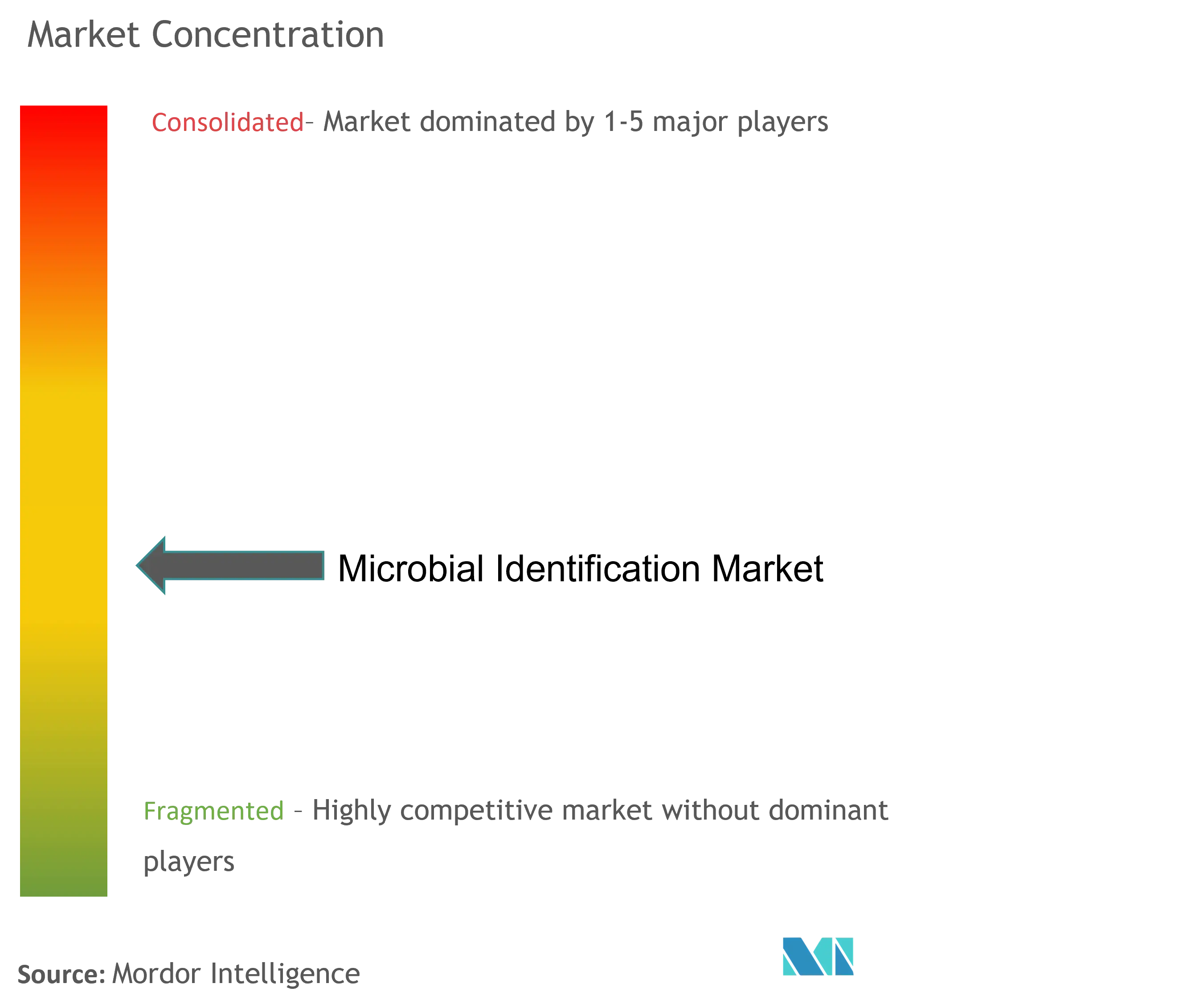Microbial Identification Market Size

| Study Period | 2019 - 2029 |
| Market Size (2024) | USD 3.76 Billion |
| Market Size (2029) | USD 5.97 Billion |
| CAGR (2024 - 2029) | 9.69 % |
| Fastest Growing Market | Asia Pacific |
| Largest Market | North America |
Major Players
*Disclaimer: Major Players sorted in no particular order |
Microbial Identification Market Analysis
The Microbial Identification Market size is estimated at USD 3.76 billion in 2024, and is expected to reach USD 5.97 billion by 2029, growing at a CAGR of 9.69% during the forecast period (2024-2029).
The COVID-19 outbreak had a significant impact on the microbial identification market due to the scarcity of microbial identification laboratory reagents and the closures of diagnostics centers and hospitals. For instance, according to an article published in October 2021 in PubMed, there was a reduction in the availability of quality laboratory reagents and consumables for bacteriology and antimicrobial susceptibility testing and the ability to service machines and equipment. Decreases were also more frequently reported by the African and Eastern Mediterranean regions. However, the market is anticipated to expand in the coming years due to the increase in food contamination issues and the rise in government funding for microbial identification testing.
Certain other factors propelling the market growth are the rising burden of infectious diseases and technological advancements in microbial identification. For instance, according to data published by the WHO in the Global Tuberculosis Report 2021, most of the tuberculosis cases were found in South-East Asia (43%), Africa (25%), and the Western Pacific (18%), and lesser numbers of tuberculosis cases were found in the Eastern Mediterranean (8.3%), the Americas (3.0%) and Europe (2.3%). Similarly, according to WHO data published in 2021, Sub-Saharan Africa likely continues to endure the burden of malaria, accounting for approximately 95% of all cases and 96% of all deaths.
Furthermore, in August 2021, the UN Environment Programme (UNEP) and Indian Council of Medical Research (ICMR) launched a new collaborative project 'Priorities for the Environmental Dimension of Antimicrobial Resistance (AMR) in India', marking an important step towards recognizing and addressing the environmental dimension of antimicrobial resistance. The project aimed to strengthen the environmental aspects of national- and state-level AMR strategies and action plans. It undertook secondary research and stakeholder consultations to enhance understanding of the environmental dimension of AMR in India. This is a sound example of how government funding is likely to boost the market.
Additionally, growing food safety concerns in packed and non-packed food are also contributing to the market growth. People are now focused more on eating processed foods, which carry a significant danger of microbial contamination.According to data published by the WHO in May 2022, an estimated 600 million people fell ill eating contaminated food. In addition, USD 110 billion was lost each year in productivity and medical expenses resulting from unsafe food in low- and middle-income countries.
Several factors contribute to the growth of the market, however, the high cost of automated microbial identification systems is likely to impede market growth over the forecast period.
Microbial Identification Market Trends
The Instruments Segment is Anticipated to Witness a Growth in the Market Over the Forecast Period
The instrument segment is expected to witness significant growth in the studied market over the forecast period owing to factors such as the rising burden of infectious diseases, growing awareness regarding microbial testing, and emerging technologically advanced products. The range of the distinguishable organism has expanded over the years to include a wider range of microorganism strains. These include techniques for rapid isolated-organism identification using mass spectrometry (MS) in clinical specimens.
With the increasing prevalence of infectious diseases, there is an increasing need to identify the microorganism causing them. According to WHO data published in July 2022, two fatal cases of Marburg virus disease (MVD) were reported from the Ashanti region, Ghana, and later tested positive for Marburg virus. Furthermore, per the global tuberculosis report 2022, the estimated number of people affected with TB was 10.6 million worldwide in 2021.
Additionally, the rising company activities in developing microbial testing products are also expected to boost segment growth over the forecast period. For instance, in July 2021, Bruker Corporation launched new products and methods for the MALDI Biotyper (MBT) platform, MALDI Biotyper Sirius, that supports workflows for the rapid, nearly universal and cost-effective microbial identification by 'proteomic fingerprinting' from culture plates and positive blood cultures. Also, in April 2021, bioMérieux received the CE-marking of VITEK MS PRIME, the next generation of the VITEK MS MALDI-TOF mass spectrometry system for routine microbial identification in minutes. In addition, in April 2022, Autobio Diagnostics Co., Ltd. showcased its fully automated microbial identification and antibiotic susceptibility testing (ID-AST) solutions at this year's ECCMID, the largest international meeting of clinical microbiologists and infectious diseases specialists. At ECCMID 2022, Autobio demonstrated the AutoMic-I600 automated ID-AST system for quick and accurate microbial identification and ID-AST that supports automatic sample pipetting, incubation, and detection.
Similarly, technological advancements in the microbial identification instrument segment are anticipated to increase segment growth over the forecast period. For instance, as per an article published in February 2021, it would be beneficial to have automated methods in the instruments to reduce the preparatory work needed, high-capacity analyses, and the ability to process a high number of strains concurrently for microbial identification.

North America is Anticipated to Witness Growth in the Microbial Identification Market Over the Forecast Period
North America is expected to witness growth in the microbial identification market over the forecast period owing to the factors such as the rising burden of infectious diseases and outbreaks of epidemics, growing concerns about food safety, and the presence of key players and product launches.
According to a November 2022 update from the CDC, 20 cases of illness and 5 cases of hospitalizations were reported for the E. coli outbreak linked to frozen falafel. The infectious disease linked with the food materials is checked through microbial identification. In addition, rising technologically advanced products and the presence of key market players in the region are also expected to boost market growth over the forecast period. For instance, in January 2022, BD received 510(k) clearance from the FDA for the BD Kiestra IdentifA system, which is designed to automate the preparation of microbiology bacterial identification testing. Also, in January 2021, Bruker Corporation launched MBT Sepsityper Kit US IVD for rapid microbial identification of more than 425 microorganisms from positive blood cultures on the MALDI Biotyper CA System.
Furthermore, concerns about food safety are anticipated to drive market growth in North America, since the government and local agencies utilize microbial identification for the detection of microbes in food. For instance, as per an article published in June 2022 in PubMed, at the federal, state, and municipal levels, different organizations are involved in the development, implementation, and enforcement of food safety policies in the United States. As a result, effective collaboration between all parties is essential for guaranteeing food safety. Local health departments (LHDs) are largely in charge of undertaking foodborne disease prevention operations, inspections of food processing and food service enterprises, and food safety education. Federal agencies are important food policy regulators.

Microbial Identification Industry Overview
The market studied is moderately competitive, with the presence of both global and local players. Few companies currently hold a healthy share of the market. For instance, Thermofisher Scientific, BioMérieux SA, Danaher (Beckman Coulter Inc.), Shimadzu Corporation, and Becton, Dickinson and Company are the major players in the market, along with local and smaller companies that hold a substantial share.
Microbial Identification Market Leaders
-
Becton Dickinson and Company
-
BioMérieux SA
-
Shimadzu Corporation
-
Thermo Fisher Scientific
-
Danaher (Beckman Coulter Inc.)
*Disclaimer: Major Players sorted in no particular order

Microbial Identification Market News
- In April 2022, Bruker Corporation advanced its new multiplex PCR infectious disease assays based on its proprietary LiquidArray technology. The company also expanded its mycobacteria portfolio with the FluoroType Mycobacteria PCR assay, launched on the high-precision FluoroCycler XT thermocycler, which uses powerful LiquidArray technology to differentiate 31 clinically relevant non-tuberculous mycobacteria and the M. tuberculosis complex from cultures in a single test.
- In March 2022, Accelerate Diagnostics, Inc. launched Accelerate Arc system, comprised of the Arc Module and BC Kit, an automated path to rapid and accurate microbial identification for positive blood cultures. The system is designed to eliminate the need for overnight culture incubation while reducing cross-reactivity and potentially false positive results that come with rapid multi-targeted molecular tests.
Microbial Identification Market Report - Table of Contents
1. INTRODUCTION
- 1.1 Study Assumptions and Market Definition
- 1.2 Scope of the Study
2. RESEARCH METHODOLOGY
3. EXECUTIVE SUMMARY
4. MARKET DYNAMICS
- 4.1 Market Overview
-
4.2 Market Drivers
- 4.2.1 Rising Burden of Infectious Diseases
- 4.2.2 Technological Advancements in Microbial Identification
- 4.2.3 Increasing Food Safety Concerns
- 4.2.4 Government Initiatives and Funding for Promoting Microbial Identification
-
4.3 Market Restraints
- 4.3.1 High Cost of Automated Microbial Identification Systems
-
4.4 Porter's Five Forces Analysis
- 4.4.1 Threat of New Entrants
- 4.4.2 Bargaining Power of Buyers/Consumers
- 4.4.3 Bargaining Power of Suppliers
- 4.4.4 Threat of Substitute Products
- 4.4.5 Intensity of Competitive Rivalry
5. MARKET SEGMENTATION (Market Size by Value - USD million)
-
5.1 By Products and Services
- 5.1.1 Instruments
- 5.1.2 Consumables
- 5.1.3 Services
-
5.2 By Method
- 5.2.1 Phenotypic Methods
- 5.2.2 Genotypic Methods
- 5.2.3 Proteomics-based Methods
-
5.3 By Application
- 5.3.1 Diagnostics
- 5.3.2 Food and Beverage Testing
- 5.3.3 Pharmaceuticals
- 5.3.4 Cosmetics and Personal Care Products Testing
- 5.3.5 Other Applications
-
5.4 Geography
- 5.4.1 North America
- 5.4.1.1 United States
- 5.4.1.2 Canada
- 5.4.1.3 Mexico
- 5.4.2 Europe
- 5.4.2.1 Germany
- 5.4.2.2 United Kingdom
- 5.4.2.3 France
- 5.4.2.4 Italy
- 5.4.2.5 Spain
- 5.4.2.6 Rest of Europe
- 5.4.3 Asia-Pacific
- 5.4.3.1 China
- 5.4.3.2 Japan
- 5.4.3.3 India
- 5.4.3.4 Australia
- 5.4.3.5 South Korea
- 5.4.3.6 Rest of Asia-Pacific
- 5.4.4 Middle East and Africa
- 5.4.4.1 GCC
- 5.4.4.2 South Africa
- 5.4.4.3 Rest of Middle East and Africa
- 5.4.5 South America
- 5.4.5.1 Brazil
- 5.4.5.2 Argentina
- 5.4.5.3 Rest of South America
6. COMPETITIVE LANDSCAPE
-
6.1 Company Profiles
- 6.1.1 Becton, Dickinson and Company
- 6.1.2 Biolog Inc.
- 6.1.3 BioMerieux SA
- 6.1.4 Bruker Corporation
- 6.1.5 Charles River Laboratories International Inc.
- 6.1.6 Danaher Corporation (Beckman Coulter Inc.)
- 6.1.7 Eurofins Scientific SE
- 6.1.8 Merck Millipore (Merck KGaA)
- 6.1.9 Shimadzu Corporation
- 6.1.10 Thermo Fisher Scientific Inc.
- 6.1.11 VWR Corporation
- *List Not Exhaustive
7. MARKET OPPORTUNITIES AND FUTURE TRENDS
** Subject To AvailablityMicrobial Identification Industry Segmentation
As per the scope of the report, microbial identification can be defined as microbial characterization by a limited spectrum of tests, which are pre-chosen and appropriate to the problem being studied.
The microbial identification market is segmented by Products and Services (Instruments, Consumables, and Services), Method (Phenotypic Methods, Genotypic Methods, and Proteomics-based Methods), Application (Diagnostics, Food, and Beverage Testing, Pharmaceuticals, Cosmetics, and Personal Care Products Testing, and Other Applications), and Geography (North America, Europe, Asia-Pacific, Middle East and Africa, and South America). The market report also covers the estimated market sizes and trends for 17 different countries across major regions globally. The report offers the value (in USD million) for the above segments.
| By Products and Services | Instruments | |
| Consumables | ||
| Services | ||
| By Method | Phenotypic Methods | |
| Genotypic Methods | ||
| Proteomics-based Methods | ||
| By Application | Diagnostics | |
| Food and Beverage Testing | ||
| Pharmaceuticals | ||
| Cosmetics and Personal Care Products Testing | ||
| Other Applications | ||
| Geography | North America | United States |
| Canada | ||
| Mexico | ||
| Geography | Europe | Germany |
| United Kingdom | ||
| France | ||
| Italy | ||
| Spain | ||
| Rest of Europe | ||
| Geography | Asia-Pacific | China |
| Japan | ||
| India | ||
| Australia | ||
| South Korea | ||
| Rest of Asia-Pacific | ||
| Geography | Middle East and Africa | GCC |
| South Africa | ||
| Rest of Middle East and Africa | ||
| Geography | South America | Brazil |
| Argentina | ||
| Rest of South America |
Microbial Identification Market Research FAQs
How big is the Microbial Identification Market?
The Microbial Identification Market size is expected to reach USD 3.76 billion in 2024 and grow at a CAGR of 9.69% to reach USD 5.97 billion by 2029.
What is the current Microbial Identification Market size?
In 2024, the Microbial Identification Market size is expected to reach USD 3.76 billion.
Who are the key players in Microbial Identification Market?
Becton Dickinson and Company, BioMérieux SA, Shimadzu Corporation, Thermo Fisher Scientific and Danaher (Beckman Coulter Inc.) are the major companies operating in the Microbial Identification Market.
Which is the fastest growing region in Microbial Identification Market?
Asia Pacific is estimated to grow at the highest CAGR over the forecast period (2024-2029).
Which region has the biggest share in Microbial Identification Market?
In 2024, the North America accounts for the largest market share in Microbial Identification Market.
What years does this Microbial Identification Market cover, and what was the market size in 2023?
In 2023, the Microbial Identification Market size was estimated at USD 3.40 billion. The report covers the Microbial Identification Market historical market size for years: 2019, 2020, 2021, 2022 and 2023. The report also forecasts the Microbial Identification Market size for years: 2024, 2025, 2026, 2027, 2028 and 2029.
Microbial Identification Industry Report
Statistics for the 2023 Microbial Identification market share, size and revenue growth rate, created by Mordor Intelligence™ Industry Reports. Microbial Identification analysis includes a market forecast outlook to 2029 and historical overview. Get a sample of this industry analysis as a free report PDF download.



